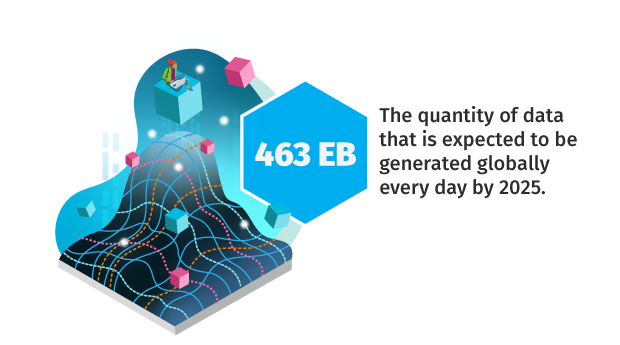

Customer Data Platforms: Solving the 5 Key Business Challenges in 2023
This comprehensive guide unpacks the potential of Customer Data Platforms (CDPs) in meeting key business challenges, providing you with in-depth case studies, insights on data governance, and a roadmap for responsible AI integration.
Download the WhitepaperIn our increasingly digitized world, data is the new currency. The value of data has skyrocketed over the past few decades, so much so that some industry experts have likened it to the value of oil, gold, and even land. We can trace this exponential and unprecedented growth to the rise of Big Data — that is, the massive quantities of structured and unstructured data that are generated each day.
Though the general concept has existed in some form or other for thousands of years, Big Data as we know it today came about in the 1990s, when organizations first began to recognize its ability to generate detailed insights into everything from consumer buying patterns to new business opportunities. What businesses have realized over time is that Big Data in its unfiltered form is akin to crude oil or raw gold — full of potential, but in need of refining. That’s where enterprise analytics comes into play.
What is Enterprise Analytics?
As its name implies, enterprise analytics refers to the collective analytical processes that an organization applies to large data sets in order to extract meaningful insights. For example, a retail organization might apply enterprise analytics to consumer data to determine which demographics its customers belong to and where to allocate marketing spend. Another example: A manufacturing company might use enterprise analytics to review historical sales and identify its peak season in order to better forecast demand.
Enterprise analytics comes in four “flavors,” so to speak:
- Descriptive Analytics: Provides insight into things that are currently happening or that have already happened; common techniques include business intelligence and data visualizations.
- Diagnostic Analytics: Provides context for why something is happening or has happened; common techniques include drill-down, data discovery, data mining, and correlations.
- Predictive Analytics: Predicts what is likely to happen, typically based on historical data; common techniques include regression analysis, forecasting, statistical modeling, and predictive modeling.
- Prescriptive Analytics: Recommends different courses of action in order to achieve desired outcomes; common techniques include graph analysis, simulation, neural networks, heuristics, and machine learning.
Find out How Predictive Analytics is Transforming the Future of Business >>
Benefits of Enterprise Data Analytics
The benefits to using enterprise analytics are seemingly limitless. With enterprise data analytics, businesses can:
- Derive value from massive quantities of data. When we say Big Data, we really do mean big — according to some estimates, roughly 463 exabytes of data will be generated globally each day by 2025. For a bit of helpful context, a single exabyte is equivalent to 1,000 petabytes, 1 million terabytes, and 1 billion gigabytes. Even if a business only collects a small fraction of that, it’s still looking at mountains of data to sift through, which can make it challenging to determine how much of that data is actually useful, let alone extract any meaningful insights from it.

Enterprise analytics platforms automate much of the data analysis process and present their findings in a more digestible format, such as a data visualization or statistical model. In doing so, enterprise analytics solutions make data insights more accessible and easier to understand, so organizations can put their findings into action and start generating ROI that much faster. - Predict outcomes and strategize accordingly. Using predictive and prescriptive analytics, businesses gain a glimpse into the future, as well as receive targeted recommendations on how to achieve desired outcomes. Armed with this information — all of it grounded in actual data and, therefore, more reliable than pure conjecture — organizations can make more strategic and informed business decisions.
- Gain clear insight into goals and objectives. Enterprise analytics isn’t just good for meeting goals and objects — it’s incredibly useful for defining them, too. By analyzing historical data, competitor data, and industry trends, an organization can get a clear picture of what it needs to do in order to turn a profit and grow market share. Additionally, businesses can use diagnostic analytics to review past performance and identify weaknesses, and prescriptive analytics to generate data-driven recommendations on how to improve.
- Anticipate customer needs. The best way for a company to understand what its customers want, as opposed to what it thinks they want, is to review customer data. Using enterprise analytics, businesses can segment their customer base by demographic, thereby gaining a clear picture of who their target audience is, what pain points they experience, and what matters most to them. This makes businesses more attuned to their customers’ wants and needs and enables them to tailor every customer interaction accordingly.
- Maximize sales and marketing spend. Speaking of tailoring interactions to the individual customer, enterprise analytics also makes it possible for organizations to maximize sales and marketing spend by speaking directly to the customer’s interests.
One of the beautiful things about enterprise data analytics is that, using software such as a customer relationship management solution, businesses can build out detailed customer profiles that include everything from personal preferences to major life milestones. This enables them to determine which messaging is most likely to resonate with and which offers and incentives are most likely to appeal to each individual customer. Based on this information, a company’s marketing team can then develop more targeted marketing campaigns, and its sales team can identify upselling and cross-selling opportunities and deliver personalized product recommendations. - Mitigate risk. Predictive analytics models make it possible to map out potential risk and build strategies in order to mitigate or prevent exposure to risk entirely. Additionally, enterprise analytics platforms typically enable you to store all of your data within a single, centralized location, thereby reducing potential risk from moving data back and forth from one system to another.
- Optimize product development. Rather than make a series of educated guesses about whether new products or improvements to existing products are likely to meet consumers expectations, businesses can get definitive answers with enterprise analytics. Enterprise data analytics platforms can evaluate social sentiment, customer opinions and preferences, and more — pulling data from a wide variety of sources — and accurately predict whether a new product or product improvement is viable.
Enterprise analytics solutions can even determine whether a research and development project is likely to be completed on time and on budget, enabling businesses to shuffle resources in order to keep things within scope and better plan for future R&D initiatives. - Share real-time results. Most enterprise data analytics solutions feature real-time reporting, enabling business leadership to gain up-to-the-minute insights — the good, the bad, and the ugly — and share them across all levels of their organization. Doing so not only ensures that everyone is kept up to date on what is happening with the business, but also fosters collaboration amongst otherwise disparate departments and teams, breaking down silos in the process.
How Do Businesses Use Enterprise Analytics?
For an example of enterprise data analytics in action, look no further than these use cases from actual Hitachi Solutions customers:
- Consumer Packaged Goods: Excess inventory poses a major problem to CPG retailers because it presents purchasing and warehousing costs; additionally, retailers must incur any loss associated with spoilage or discounted sales. When one of the nation’s largest organic and specialty food distributors realized that it wasn’t optimizing its inventory levels and costs to cover stock outs, it came to Hitachi Solutions for help.
By modeling the company’s planning and promotions using Microsoft Azure and Databricks, Hitachi Solutions was able to help this distributor achieve savings in the double digit millions without sacrificing customer satisfaction. - Manufacturing: A manufacturing client that specializes in building some of the world’s most reliable fire safety and rescue equipment partnered with Hitachi Solutions to build a cloud-based analytics platform for its connected vehicle hardware for ambulances and fire trucks. This hardware is designed in such a way that it connects the operational and diagnostic data streaming from the engine, water pumps, water valves, water cannon, and so on. For this project, Hitachi Solutions created an Azure-based advanced analytics platform to aggregate this data and present it to vehicle manufacturers, dealers, and, ultimately, the emergency service teams operating those vehicles, enabling them to access data-driven insights.
- Insurance: A leading North American insurance brokerage that provides business and personal insurance products and services faced challenges aggregating data from disparate data sources. The brokerage used legacy systems that required roughly 38 hours to process data from various sources, which enabled it to load data and perform analytics only once a week. These legacy systems and processes prevented the brokerage’s marketing and customer service departments from performing meaningful analytics and providing customers with quality service in a timely manner.
To solve these business challenges, Hitachi Solutions built an advanced analytics platform that enables the client to load data on a daily basis in just under five hours at a significantly reduced cost. This platform not only made it possible for the brokerage to draw insights in a timely manner, but also to tailor its product offerings to meet ever-changing customer needs. - Retail: When one of the world’s largest retailers sought a way to provide its merchandise and planning teams with access with rich data, it turned to Hitachi Solutions for support. Using Azure and Power BI, Hitachi Solutions was able to grant merchandisers access to millions of rows of 1010 data, so that they could make more insightful product placement and pricing decisions to enhance brand performance and maximize profitability.
What is Enterprise Data Strategy & Why Do You Need One?
An enterprise data strategy is an organization’s comprehensive, long-term plan for implementing enterprise data analytics at every level of business.
For any organization interested in harnessing the power of Big Data, the importance of having such a strategy in place cannot be overstated. That’s because an enterprise data strategy:

When developing an enterprise data strategy, it’s best practice to ensure that your plan is easy to execute, specific to the needs of your business, and adaptable, and that it’s applied consistently across your entire organization.
Develop a Winning Enterprise Data Strategy with Hitachi Solutions
Whether you’re getting ready to develop your first enterprise data strategy or your hundredth, it never hurts to have a seasoned professional on your team. That’s why here at Hitachi Solutions, we’ve built an entire business unit dedicated to helping organizations such as yours derive valuable insights from Big Data. From data and analytics services to a dedicated data science team, we offer a vast library of resources and enterprise analytics expertise to help you drive the needle forward.
Contact us today to get on the Information Track and start seeing real results from your data.


